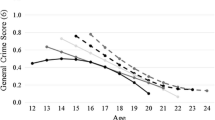Abstract
The use of generalized estimating equations and time-series methods for fitting longitudinal models in the National Crime Victimization Survey (NCVS) is discussed, with reference to the relation between the reporting of a violent crime to the police and previous victimizations. Two longitudinal models are fit to NCVS data to predict the likelihood of reporting a violent crime to the police based on characteristics of the victim and the incident and based on previous victimization experiences. In both models, it is found that higher reporting rates are associated with positive results accruing from reporting previous victimization to the police.
Similar content being viewed by others
References
Biderman, A. D., and Cantor, D. (1984). A longitudinal analysis of bounding, respondent conditioning and mobility as sources of panel bias in the National Crime Survey.Proceedings of the Section for Survey Research Methods, American Statistical Association, pp. 708–713.
Bonney, G. E. (1987). Logistic regression for dependent binary observations.Biometrics 43: 951–974.
Cantor, D. (1989). Substantive implications of selected operational longitudinal design features: The National Crime Survey as a case study. In Kasprzyk, D., Duncan, G., Kalton, G., and Singh, M. P. (eds.),Panel Surveys, Wiley, New York, pp. 25–51.
Fienberg, S. E. (1980). The measurement of crime victimization: prospects for panel analysis of a panel survey.Statistician 29: 313–350.
Fienberg, S. E. (1989). Modeling considerations: discussion from a modeling perspective. In Kasprzyk, D., Duncan, G., Kalton, G., and Singh, M. P. (eds.),Panel Surveys, Wiley, New York, pp. 566–574.
Greenberg, M. S., and Ruback, R. B. (1985). A model of crime victim decision making.Victimology 10: 600–616.
Harlow, C. W. (1985). Reporting Crimes to the Police: Bureau of Justice Statistics Special Report, U.S. Government Printing Office, Washington, D.C.
Hoem, J. M. (1989). The issue of weights in panel surveys of individual behavior. In Kasprzyk, D., Duncan, G., Kalton, G., and Singh, M. P. (eds.),Panel Surveys, Wiley, New York, pp. 539–565.
Kidd, R. F., and Chayet, E. F. (1984). Why do victims fail to report? The psychology of criminal victimization.J. Social Issues 40: 39–50.
Lehnen, A. G., and Reiss, A. J. (1978). Response effects in the National Crime Survey.Victimology: 110–124.
Liang, K. Y., and Zeger, S. L. (1986). Longitudinal data analysis using generalized linear models.Biometrika 73: 13–22.
Liang, K. Y., Zeger, S. L., and Albert, P. S. (1988). Models for longitudinal data: A generalized estimating equation approach.Biometrics 44: 1049–1060.
Lohr, S., and Liu, J. (1992). A comparison of weighted and unweighted analyses in the NCVS near-term data. Paper presented at the 44th Annual American Society of Criminology Meetings.
Miethe, T. D., Stafford, M. C., and Sloane, D. (1990). Lifestyle changes and risks of criminal victimization.J. Quant. Criminol. 6: 357–376.
Saphire, D. G. (1984).Estimation of Victimization Prevalence Using Data from the National Crime Survey, Lecture Notes in Statistics Vol. 23, Springer-Verlag, New York.
Shapland, J., Willmore, J., and Duff, P. (1985).Victims in the Criminal Justice System, Gower, Brookfield, VT.
Skogan, W. G. (1984). Reporting crimes to the police: The status of world research.J. Res. Crime Delinq. 21: 113–137.
Stasny, E. A. (1991). Hierarchical models for the probabilities of a survey classification and nonresponse: An example from the National Crime Survey.J. Am. Stat. Assoc. 86: 296–303.
U.S. Department of Justice, Bureau of Justice Statistics (1990).National Crime Surveys: National Sample, 1986–1989 (near-Term Data) (Computer file), 3rd ICPSR ed., conducted by the U.S. Department of Commerce, Bureau of the Census, Inter-university Consortium for Political and Social Research, Ann Arbor, MI (producer and distributor).
U.S. Department of Justice, Bureau of Justice Statistics (1991).Criminal Victimization in the United States, 1989, U.S. Government Printing Office, Washington, D.C.
U.S. Department of Justice, Bureau of Justice Statistics (1992).Criminal Victimization in the United States, 1990, U.S. Government Printing Office, Washington, D.C.
Waller, I. (1990). The police: First in aid? In Lurigio, A. J., Skogan, W. G., and Davis, R. C. (eds.),Victims of Crime: Problems, Policies and Programs, Sage, Newbury Park, CA, pp. 139–156.
Zeger, S., and Liang, K. Y. (1992). An overview of methods for the analysis of longitudinal data.Stat. Med. 11: 1825–1842.
Zeger, S., Liang, K. Y., and Albert, P. S. (1988). Models for longitudinal data: A generalized estimating equation approach.Biometrics 44: 1049–1060.
Author information
Authors and Affiliations
Rights and permissions
About this article
Cite this article
Conaway, M.R., Lohr, S.L. A longitudinal analysis of factors associated with reporting violent crimes to the police. J Quant Criminol 10, 23–39 (1994). https://doi.org/10.1007/BF02221007
Issue Date:
DOI: https://doi.org/10.1007/BF02221007




